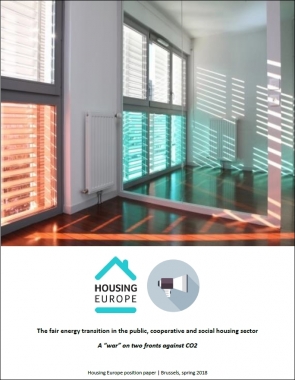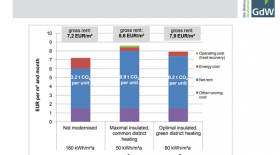Decarbonisation of the building stock: a two-front battle
A Housing Europe position paper
Brussels, 17 April 2018 | Published in Energy
On Tuesday 17 April, the European Parliament cast the final vote on the revised Energy Performance of Buildings Directive. The main novelty is contained in article 2 which provides that “Member States shall establish a long-term strategy to support the renovation of the national stock of residential and non-residential buildings, both public and private, into a highly energy efficient and decarbonised building stock by 2050, facilitating the cost-effective transformation of existing buildings into nearly-zero energy buildings”. Housing Europe has gathered the expertise of its members to develop a vision of the optimal approach for a fair energy transition and the decarbonisation of the building stock in line with new article 2 of the EPBD. On 18 April, the EU energy ministers will gather to discuss future energy challenges and the implementation of EU energy policies. Housing Europe calls them to take into account the holistic approach promoted in this paper. Furthermore, as part of its evidence gathering efforts, Housing Europe will publish in May a comparative study on the financing of renovation of social housing to shed light on the complex nature of renovation activities.
I. In brief
The objectives of this briefing are firstly to explain how renovation activities are decided and implemented by housing companies, secondly to discuss what policies are the most effective to achieve the fair energy transition in the social, cooperative and public housing sectors, and therefore to inform EU policy making in the field of energy.
With this paper, Housing Europe intends to contribute to the discussion on the future EU policies and funding programmes for energy and climate.
II. Introduction
Over the past 10 years, there has been a growing consensus about the role of housing in meeting EU climate objectives, but also many simplistic proposals haven been put forward in the debate about how to increase renovation of dwellings in the EU. This paper intends to bring reality back into the policy discussion.
If one wants to have a short look back at how the European policy makers have dealt with the topic of renovation of housing over the last few years, 2010 would probably be a turning point. That year, on the one hand, the Global Financial Crisis and the various attempts to launch economic recovery plans at the EU and national level effectively put the housing sector and in particular the renovation of the existing stock at the centre of political concern because of its growth-enhancing role. On the other hand, the European Directive on Energy Performance of Building was adopted and it paved the way for more energy efficient new dwellings as well as set the incentives for the renovation of existing dwellings.
Almost 6 years on, the role of renovation of existing buildings has been even more stressed by a wide range of stakeholders and policy makers, referring in particular to the Paris Climate Agreement and its translation at the EU level. In a recent publication, the EU Joint Research Centre called energy renovation the “trump card for the new start for Europe”. Furthermore, the European Commission published in December 2016 a set of new proposals on how to step up the renovation of the building stock as a way to meet the EU climate targets.
To sum up the general idea promoted by many stakeholders, in particular from the insulation industry: let’s first renovate EU buildings at the highest level of performance and things will get better for the climate.
This paper intends to rethink the place of energy efficiency in social, public and cooperative housing in the overall strategy to limit CO2 emissions and thus to put into question simplistic policy proposals based on catchy slogans rather than solid evidence. It will highlight the importance on taking into account both the reduction of energy needs at the level of the buildings or neighbourhoods but also the type of energy provision for the residents (the” two-front battle”).
In the first part of this paper, we will present some facts about energy efficiency in the social, cooperative and public housing sectors. This intends to illustrate the complex reality of buildings renovation. In the second part, we will draw some conclusions about the right approach to support the fair energy transition.
III. 8 facts about energy efficiency in the social, cooperative and public housing sector[1]
- Energetic retrofitting is always undertaken in the course of a substantial renovation project which usually takes place after 30 – 40 years after completion of the building. The measures taken are mainly insulation of the outer façade, the roof and cellar; partially together with the renewal or rather exchange of windows. The heating system is not always integrated in the renovation operation. Additional measures are the renewal of the roofs, modernisation of the elevator, the lightening system and some other minor repairs. Adding elevators is done in a part of smaller buildings not equipped with that facility from the beginning. This is a huge costs factor, depending on the size of the building.
- The average energy performance of social, cooperative and public housing is better than the one of the other sectors (private rental and homeowners); for instance in France 190 kwh/m²/ year for social housing vs. 250 kwh/m²/y for the entire stock. In Germany, the average energy use for dwellings in 6 Mio GdW-housing companies is 130 kWh/m²a, while the German average is 155 kWh/m²a.
- Renovations have almost always energy and non-energy related component. The non-energy component usually makes most of the cost of renovation. It might come from the fact that from the housing providers point of view, there is not (yet) a specific approach for energy efficiency but rather an approach of building modernization and increased comfort for tenants.
- The cost of the energy-related part of renovation makes on average below 50% of the total cost of renovation. In several countries, typical energetic renovation works cost around 10K€ per apartment (average 60 m²).
- Renovations are financed via a mix of own funding, soft loans related to the energy part of the renovation, bank loans, bonds issue, non-repayable grants, and contribution of tenants in the form of rent increase or rent provision.
- Soft loans related to the energy part of the renovation are conditioned to the attainment of specific levels of energy efficiency and they are all the more favourable as this level is high.
- Subsidies are also conditioned to the realisation of energy efficiency objectives.
- In most of the cases, major renovations and the related rent increase need the agreement of the tenants, however, this is not always the case
IV. What is the best approach for a fair energy transition? Seeking the right balance between energy reduction and clean energy production
As shown by the latest Eurostat statistics on energy savings, the drivers of energy demand in 2016 are multiple: 1) GDP growth; 2) increasing heating and cooling degree days; and 3) increasing population and therefore, even with strict rules in terms of energy efficiency, it is difficult to predict energy demand. It is therefore unclear how effective energy efficiency programmes are at reducing energy use.
Despite this uncertainty, the discussion on the role of buildings in the energy transition over the last years has been almost exclusively focused on energy efficiency measures. At the local level on the contrary, the normal practice is to find the right combination between the optimal reduction of energy need and the adequate low-GHG-energy supply.
Social, cooperative and public housing companies look at the most cost-effective way to increase the safety and comfort of their residents but also the life cycle of the buildings. The decision to renovate a building goes together with strategic thinking regarding the supply of energy as well as considerations related to the wider neighbourhood. Renovation of social, cooperate and public housing never takes place in silo. There is a wide range of factors to take into account, in particular the life cycle of the buildings: major renovation takes place on average every 30 year and decisions are made based on the consideration of economic factors for the housing providers, comfort and affordability for residents, availability of renewable energy sources as well as technical solutions. Housing companies will consider various options taking into account those criteria and choose the most cost-effective one. The chosen option is the one which will increase the comfort of tenants, reduce CO2 emissions and maintain affordability.
Here are some examples of analysis of the best options for renovation:
- In the city of Wiesbaden, the social housing company decided to renovate 2 buildings of the same unit at two different levels: the passive house option and the low energy home option. Taking into account the higher cost of renovation in the passive house option, the reduction of habitable surface in the passive house option but also the greater energy savings in the passive house option, the company came to the conclusion that the low energy home option was the most cost-effective, while maintaining affordability (lower increase of rents) and comfort for the tenants. Ultimately the heating needs will be higher than for the passive house standard but they will be partly covered by renewable energy installations.
- In the Netherlands, the social housing companies involved in the Energiesprong approach reduce the energy consumption of thousands of dwellings and cover the remaining heating needs using heat pumps and PV panels.
- The diagram below using data from a real project in Germany illustrates the difference between the scenario without renovation, the scenario with the maximum of energy efficiency but without decarbonisation of energy supply and eventually the scenario with energy efficiency and decarbonisation of energy supply:
The result is that the scenario which minimise CO2 emissions and rent increase is the third scenario.
Public policies aiming at reducing the amount of CO2 emissions should therefore support this dual approach while always taking into consideration the affordability for providers and tenants. That is why Housing Europe has always called for a systematic consideration of cost effectiveness and technical feasibility of required measures, such as individual metering of energy consumption. But this is also true for mandatory obligation of renovation, which could have severe financial and social consequences, while, as we saw above, with no guarantee regarding energy use and CO2 emissions.
V.Conclusion
The contribution of the social, cooperative and public housing to a greener, more sustainable world demands a war on two fronts: a rapid and substantial increase in available green energy (solar, wind, thermal) and a better insulation of our dwellings. Affordable housing providers will have to tackle the CO2 reduction challenge on these two fronts.
